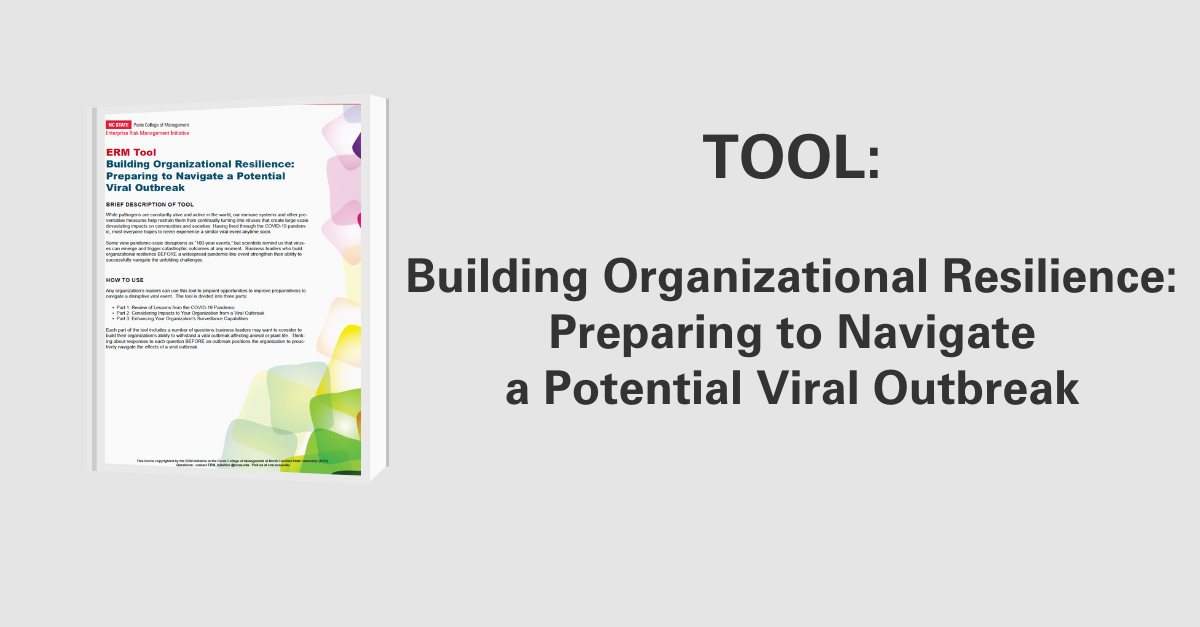NYSE Perspectives on Governance and Risk Management in Today’s Economy
Glenn W. Tyranski, the Senior Vice President of Financial Compliance at New York Stock Exchange (NYSE) Regulation, spoke at the March 20, 2009 ERM roundtable about the evolving roles of NYSE Regulation and emerging issues surrounding accounting standards, corporate responsibility, and risk assessment. The NYSE, through a merger with Euronext in 2007 and other investments and strategic alliances over the last decade, is encompassing a more global footprint and has greatly consolidated trading. NYSE Euronext is now a public company with its registrants comprising a global market capitalization of over $15 trillion.
NYSE Regulation
NYSE Regulation is a not-for-profit subsidiary of NYSE, with a separate board and senior management that arose five years ago partially due to oversight challenges. NYSE Regulation is comprised of three divisions: Market Surveillance, Listed Company Compliance, and Enforcement. NYSE Regulation is entrusted with the development and oversight of listing standards and has set stringent financial listing requirements and corporate governance standards. The work of NYSE Regulation is overseen by the Securities and Exchange Commission (SEC) and the NYSE’s Listing and Compliance Committee. NYSE Regulation is responsible for acquiring new exchange listings, working with continued listings, and public policy and works with many other organizations such as the SEC, Public Company Accounting Oversight Board, Financial Accounting Standards Board (FASB), and the International Accounting Standards Board in fulfilling these responsibilities.
The current marketplace has been slow for new listings and there have been large swings in the NYSE over short periods of time that can be tied to many factors from company-specific factors to changing regulations. The NYSE is currently experiencing record levels of noncompliance that have not been seen since 2000-2001. There is currently a 3% noncompliance rate on the exchange, which leaps to a 16% noncompliance rate when looking at penny stocks that typically trade for under $5 per share. However, other markets experience 50% noncompliance rates so NYSE listings are still very compliant from a global perspective. In 2008, there were 54 delisting and 66 new listings, significantly down from an average of 300 in many years. Because of this decline, year-to-year global IPO proceeds were down 68%. One significant difference in the current downturn from that of 2001 is that the current downturn is not limited to one industry, but is affecting the market as a whole.
Current Economic Conditions
With the economy in its current condition, consumer confidence levels are at all-time lows and home prices have seen sixteen months of continuous decline. Much of the current problem stemmed from unrealistically low perceptions of risk and excessive liquidity. Risk models do not account for the effects of significant declines in liquidity like those that have occurred, so there was excessive risk-taking in the marketplace. The mortgage business changed from an originate and hold model to an originate and distribute model. Financial institutions especially have felt the effects of this period of ineffective risk management, oversight, and foresight. In looking at how the economy arrived at its current point, many are asking where the regulation was and criticizing the adequacy of due diligence and curiosity applied. One common denominator for many companies in their current condition is that they had too much debt or, now, lack the ability to access debt.
The past several years have also seen a dramatic shift in trading, with large increases in over-the-counter derivatives and swaps. This resulted in unbundling risk and decreasing risk in some ways by sharing it across many organizations, but at the same time the absolute amount of risk was greatly increasing. The increase in derivatives trading also resulted in large amounts of paper assets and liabilities building up on organizations’ books while the derivatives remained unsettled. Then, in a time of distress, settling started to occur, drastically changing the financial condition of many organizations.
Solutions to our current economic state will need to be global. It is difficult to regulate when there is panic in the marketplace and some at least partially blame the absence of regulations against short-selling on the panic. Many are currently calling for the return of the uptick rule that has been absent since 2007. However, it bears keeping in mind that problems have not only occurred due to short sales, but there have also been long-term holders unwinding positions that causes problems for thinly traded stocks. The Troubled Assets Relief Program, which originally was created to purchase troubled assets, morphed into a program to try to stimulate lending. However, ten of the thirteen largest banks have actually decreased their outstanding loans over this time so its success has not yet been fully realized for this initiative.
Accounting Standards
Many issues about accounting standards have come to the forefront because of the current market conditions. One issue is the complexity of financial statements as they can be difficult even for boards and senior management to understand, which suggests they are likely very difficult for the average investor to fully understand. Another issue is that the Sarbanes-Oxley Act and accounting standards have not seemed adequate in some respects as many failed companies have had unqualified audit opinions issued, causing a lack of confidence in financial reporting. Financial statements also age quickly, making timing, disclosure, and transparency more critical than ever.
Global accounting development is also being shaped by political events. The appropriateness of fair-value accounting is currently being debated. Some argue that fair-value accounting allows more relevant, timely, and comparable values than other methods even if valuation is difficult. Others feel that fair-value measurement causes procyclicality as, for example, devaluation can lead to further problems if covenants are no longer able to be met. In response to these issues, the FASB has proposed more guidance on fair-value accounting that may allow reporting at other than fire-sale prices. The roadmap to convergence with International Financial Reporting Standards is being discussed at the NYSE. Other significant current accounting issues deal with going concern issues, impairments, and pension plan reporting.
Corporate Responsibility
In recovering and learning from current market conditions, business leaders must work to restore credibility by reaching new levels of transparency and accountability. Management also needs to recognize that, while shareholders are significant stakeholders and earnings are therefore important, there are other objectives for which and stakeholders to whom a company is responsible. By improving in areas such as disclosure, the government’s position as a shareholder in so many corporations can then be short-lived.
In response to these issues of corporate responsibility, the SEC is taking on a new project looking at board oversight and potentially risk management. The roles and duties of boards are changing as well. Boards that started in more advisory roles are now expected to also serve monitoring roles, set an effective tone-at-the-top, and be proactive in dealing with issues facing their companies.
Risk Assessment
While risk assessment was viewed as important before, the ability for sweeping changes to occur quickly and on a global scale has heightened the visibility of the importance of risk assessment. There are several ways in which risk assessment was not working successfully that contributed to the current market problems. These shortfalls included too much of a short-term perspective, boards not exercising enough oversight, risk managers operating in vacuums, and overreliance on risk models.
In moving forward, there are many areas in which risk assessment can be strengthened in organizations. Risk assessment frameworks need to be strong enough to support business goals and risk assessment needs to permeate and be sufficiently communicated throughout the organization. Risk management is an ongoing process and involves identifying, tracking, and managing, not controlling, risks. Risk should be a regular agenda item for boards. Finally, organizations need to remember that there is more than just credit risk; there are also market risks, reputation risks, and others that should be of concern.
There are also several more general approaches to risk assessment that apply to the market as a whole. Currently, the government is considering the establishment of a systemic risk regulator. This could be difficult to do as it is hard to define systemic risk or point to a specific cause. This regulator might deal mostly with companies large enough that their failure could cause systemic risk. Companies throughout the market need to remember not to lose sight of long-term issues just because there are short-term issues being focused on now. In recent years, many companies failed to contemplate systemic risk and a culture of excessive risk-taking was tolerated. Now, the pendulum has swung, and the current climate is very risk-averse. One benefit from the downturn we are experiencing is that there is increased thinking about risks versus rewards in making business decisions that will hopefully continue even as the markets improve.
Synopsis of Mr. Tyranski’s presentation prepared by Beth Taylor, 2009 Master of Accounting student and ERM Initiative faculty.


